Evidence for the involvement of dopamine transporters in behavioral stimulant effects of modafinil
- PMID: 19197004
- PMCID: PMC2672878
- DOI: 10.1124/jpet.108.146142
Evidence for the involvement of dopamine transporters in behavioral stimulant effects of modafinil
Abstract
Modafinil is prescribed for numerous medical conditions, but the drug's mechanism of action is unclear. Here, we examined the interaction of modafinil with receptors and transporters in vitro and compared pharmacological effects of the drug with those produced by indirect dopamine (DA) agonists 1-[2-[bis(4-fluorophenyl)methoxy]ethyl]-4-(3-phenylpropyl)piperazine (GBR12909) and (+)-methamphetamine (METH). Modafinil was screened at various receptors and transporters using binding assays. Transporter-mediated uptake and release were examined in rat brain synaptosomes. Effects of modafinil on motor activity and neurochemistry were determined in rats undergoing in vivo microdialysis in nucleus accumbens. Of the receptors and transporters assayed, modafinil displayed measurable potency only at DA transporters (DAT), inhibiting [(3)H]DA uptake, with an IC(50) value of 4.0 microM. Accordingly, modafinil pretreatment (10 microM) antagonized METH-induced release of the DAT substrate [(3)H]1-methyl-4-phenylpyridinium. Intravenous modafinil (20 and 60 mg/kg) produced dose-dependent increases in motor activity and extracellular DA, without affecting serotonin (5-HT). Analogous results were observed for GBR12909 (1 and 3 mg/kg), whereas METH (0.3 and 1 mg/kg) increased DA and 5-HT. Locomotor effects of all drugs were positively correlated with dialysate DA (P < 0.001). Interestingly, modafinil pretreatment reduced METH-induced ambulation and DA release. Our data show that modafinil interacts with DAT sites in rat brain, a property shared with agonist medications under investigation for treating cocaine dependence. Nondopaminergic mechanisms may also contribute to the pharmacology of modafinil. Finally, the results suggest that modafinil should be tested as an adjunct for treating METH addiction.
Figures

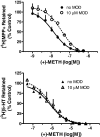

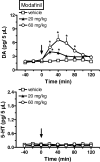


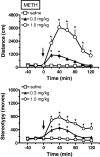
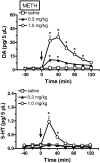





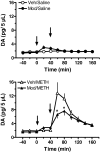
References
-
- Armbruster BN and Roth BL (2005) Mining the receptorome. J Biol Chem 280 5129-5132. - PubMed
-
- Ballon JS and Feifel D (2006) A systematic review of modafinil: potential clinical uses and mechanisms of action. J Clin Psychiatry 67 554-566. - PubMed
-
- Baumann MH, Ayestas MA, Sharpe LG, Lewis DB, Rice KC, and Rothman RB (2002) Persistent antagonism of methamphetamine-induced dopamine release in rats pretreated with GBR12909 decanoate. J Pharmacol Exp Ther 301 1190-1197. - PubMed
-
- Baumann MH, Char GU, De Costa BR, Rice KC, and Rothman RB (1994) GBR12909 attenuates cocaine-induced activation of mesolimbic dopamine neurons in the rat. J Pharmacol Exp Ther 271 1216-1222. - PubMed
Publication types
MeSH terms
Substances
LinkOut - more resources
Full Text Sources
Other Literature Sources
Miscellaneous

